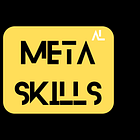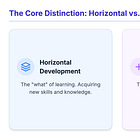Algorithm & Authenticity: The 5 New Rules of Leadership in the AI Era
Becoming the kind of leader AI can’t replace.
The new rules of work
As I reflect on my leadership journey and what AI is doing to our future, I feel a mix of excitement and worry. We’re moving fast, but not always wisely. I see leaders outsourcing judgment to tools, trading depth for speed, and calling it progress.
About this AI-shaped future: I’m hopeful and also very much concerned. Hopeful because the tools are powerful. Concerned because I see less listening, less courage, and too much “optimize and move on.” Leadership is becoming a sprint. People are not built for sprints alone.
For years, we have been trained as leaders to treat problems like machines: take them apart, fix the broken part, put them back together. That made sense in a complicated world. But today, we’re not in a complicated world - we’re in a complex one.
Before AI, the world was complicated - and we solved problems that were hard - but “solvable”. Before AI, most business challenges looked like this: scaling operations, optimizing logistics, improving efficiency. Tough, yes - but still within the “if X then Y” problem-solving approach.
Now & in the future with AI - the world is complex and unpredictable, but adaptive. There are no manuals that guarantee success. Every action changes the system itself, and the system adapts in return. In the AI era, we’re operating in this world: markets shift overnight, technologies evolve faster than regulations, and human behavior adds layers of unpredictability. These are not puzzles to be solved once - they’re living dynamics we need to dance with.
This isn’t just about learning a new tool. It’s about becoming a different kind of leader. One who knows when to lean on algorithms, and when to lean harder into the most human parts of leadership.
In the complicated world, leadership was about expertise, control, and optimization. In the complex world, leadership is about curiosity, adaptability, and systems thinking.
So in this article, I wrote about my worries and 5 things my human heart & brain are telling me are the right things to focus on as leaders leading in an AI present & future. Here are five rules I believe every leader needs to navigate this new era.
1. The AI paradox: the more we use AI, the more human we need to be
Here’s the irony: the more tasks AI takes off our plates, the more valuable our human skills become. Wait - what?
AI can analyze data in seconds. It can synthesize information faster than we ever will. But it can’t sit across from someone who’s just been laid off and show empathy (I hope not!). It can’t build trust when a team is under pressure. It can’t weigh ethics when every choice looks profitable on paper.
Practical shift: Stop treating empathy, trust, and critical thinking as “soft add-ons.” They’re your leadership core.
If the context evolves, the leader must, too. Yesterday proved you. Tomorrow will stretch you. It’s not more AI that leadership of the AI future will require. It’s more human.
2. Stop “solving” problems and start “dancing” with them
Here’s the trap many leaders fall into: we try to fix complex challenges the way we’d fix a leaky pipe. But problems like climate change, market volatility, or even workplace culture don’t have quick fixes.
They’re not puzzles. They’re ecosystems.
Which means the role of a leader isn’t to control complexity, but to dance with it. To see patterns. To ask better questions. To stay curious when the system feels messy and unpredictable.
Here’s the part most people miss: you’re not standing outside the system looking in. You’re part of it. Your perspective, your biases, your blind spots - they shape the very system you’re trying to lead.
Practical shift: Next time you’re tempted to jump straight to solutions, pause. Ask: What’s the system here really doing? And what role am I playing in it?
3. Upgrade your operating system, not just your apps
Think of leadership growth like a phone. Horizontal development is like downloading new apps - new skills, new certifications, new frameworks. Important, but limited.
Vertical development is different. It’s like upgrading the operating system itself. Suddenly, all your apps run better. You can handle more complexity, hold multiple perspectives, and stay steady in uncertainty. I wrote quite a lot about this topic - here are a few articles if you’d like to read more about my vision about vertical development and why it's crucial for this AI age.
This is what most leaders miss: we keep adding apps without upgrading the OS. And then we wonder why the system keeps crashing.
Practical shift: Invest in growth that stretches how you think, not just what you know. Coaching, reflection, feedback loops, and uncomfortable conversations are the upgrade buttons.
Analog leadership won’t survive a digital tide. The job changed. The world changed. The thinking must, too.
4. The true purpose of a system is what it does
Every company has a shiny mission statement. But the real purpose of a system isn’t what it says - it’s what it consistently does.
A prison might claim to rehabilitate, but if its outcomes produce repeat offenders, its true purpose is something else. A company might say “people first,” but if all its incentives reward short-term profit, the system is designed for something entirely different.
Leaders who miss this get fooled by the story. Leaders who see it gain clarity - and the power to shift it.
Practical shift: Don’t just read the mission statement. Watch the outcomes. That’s the truth.
5. AI gives the answers. Humans do the meaning-making.
AI is great at spotting patterns. It can map interrelationships that would take us months. But give two leaders the same AI-generated insights, and they’ll still make different calls.
Why? Because meaning-making is human work. We set the priorities. We weigh the trade-offs. We choose values over shortcuts.
That’s the future of leadership: letting AI do the heavy lifting of analysis, while we do the harder work of wisdom, judgment, and direction. Critical thinking. Systems thinking.
Practical shift: Use AI to give you the options. Use your humanity to choose the path.
From knowing to becoming
This is the real shift. AI handles what you know. The question is: who are you becoming?
The leaders who thrive in this era won’t just be skilled - they’ll be deeply human. They’ll see complexity as a dance, growth as an upgrade, and AI as a system partner, not a threat.
The future will reward people who can feel, decide, and hold paradox - not people who can recite frameworks and playbooks. Be that person.
Let AI carry the answers. You carry the questions that matter - the ones about meaning, courage, and care. Use AI for speed & facts. Use your humanity for direction. Lead with both.
About me
I’m a leadership development consultant, certified coach, and digital transformation strategist with 18 years of experience leading people, operations, L&D and organizational change. I specialize in guiding leaders through complex transformations in the age of AI, with expertise in change management, leadership development, and workplace culture. As the author of Atomic Leadership on Substack, I share actionable insights that empower leaders, teams, and organizations to thrive in fast-changing environments. Follow me on LinkedIn or Connect.




